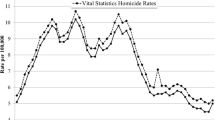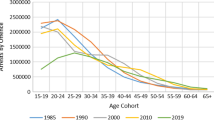Abstract
It is now almost a quarter of a century since Adler (1975) and Simon (1975)stimulated a debate about the convergence of crime rates for men andwomen. The ensuing debate generated literally dozens of papers. Given theexistence of a series that now extends from 1960 to 1995, this papersuggests an appropriate way to examine the convergence hypothesis usingtime series techniques. These techniques take into consideration the effectsof the following factors: (a) random “shocks” or“innovations,” (b) the potentially lasting effects of suchinnovations, and (c) the autocorrelation that time series oftenexhibit. Using time series techniques on annual data, we examine trends inthe arrest rates for males and females for six Part I crimes (homicide,robbery, aggravated assault, burglary, larceny, and motor vehicle theft)for the years 1960 through 1995. We test for convergence, divergence, notrend, and a special condition of equilibrium between series calledcointegration.
Similar content being viewed by others
REFERENCES
Adler, F. (1975). Sisters in Crime, McGraw-Hill, New York.
Austin, R. L. (1993). Recent trends in official male and female crime rates: The convergence controversy. J. Crim. Just. 21: 447–466.
Bonger, W. A. (1916). Crime and Economic Conditions, Little, Brown, Boston.
Bureau of the Census (selected years). Current Population Surveys: Series P-25, Government Printing Office, Washington, DC.
Darrow, C. (1922). Crime: Its Causes and Treatment, Patterson-Smith, Montclair, NJ.
Engle, R. F., and Granger, C. W. J. (1987). Co-integration and error correction: representation, estimation, and testing. Econometrica 55: 251–276.
Engle, R. F., and Granger, C. W. J. (1991). Introduction. In Engle, R. F., and Granger, C. W. J. (eds.), Long-Run Economic Relationships: Readings in Cointegration, Oxford University Press, New York.
EVIEWS (1994). EVIEWS: Econometric Views, Quantitative Micro Software, Irvine, CA.
Federal Bureau of Investigation (1961–1996). Crime in the United States, Government Printing Office, Washington, DC.
Hamilton, J. D. (1994). Time Series Analysis, Princeton University Press, Princeton, NJ.
Hindelang, M. J. (1979). Sex differences in criminal activities. Social Problems 27: 143–156.
Ivkovich, S. K. (1995). Analysis of robbery in light of the convergence hypothesis. J. Crime Just. 18: 143–160.
MacKinnon, J. G. (1991). Critical values for cointegration tests. In Engle, R. F., and Granger, C. W. J. (eds.), Long-Run Economic Relationships: Readings in Cointegration, Oxford University Press, New York, pp. 267–276.
Noblit, G. W., and Burcart, J. M. (1976). Women and crime: 1960–1970. Soc. Sci. Q. 56: 650–657.
Norland, S., and Shover, N. (1977). Gender roles and female criminality: Some critical comments. Criminology 15: 87–104.
O'Brien, R. M. (1988). Exploring the intersexual nature of violent crimes. Criminology 26: 151–170.
O'Brien, R. M. (1995). Crime and victimization data. In Sheley, J. F. (ed.), Criminology: A Contemporary Handbook, Wadsworth, Belmont, CA, pp. 57–81.
Rosenfeld, R. (1997). Changing relationships between men and women: A note on the decline in intimate partner homicide. Homicide Stud. 1: 72–83.
Simon, R. J. (1975). Women and Crime, D. C. Heath, Lexington, MA.
Simon, R. J. (1976a). Contemporary Women and Crime, National Institute of Mental Health, Washington, DC.
Simon, R. J. (1976b). Women and crime revisited. Soc. Sci. Q. 56: 658–663.
Steffensmeier, D. J. (1980). Sex differences in patterns of adult crime, 1965–1977: A review and assessment. Soc. Forces 58: 1080–1108.
Steffensmeier, D. J. (1993). National trends in female arrests, 1960–1990: Assessment and recommendations for research. J. Quant. Criminol. 9: 411–441.
Steffensmeier, D. J., and Cobb, M. J. (1981). Sex differences in urban arrest patterns, 1934- 1979. Soc. Problems 29: 37–50.
Steffensmeier, D. J., and Streifel, C. (1992). Time-series analysis of the female percentage of arrest for property crimes, 1960–1985: A test of alternative explanations, Just. Q. 9: 77–103.
Sellin, T. (1931). The basis of a crime index. J. Am. Inst. of Crim. Law Criminol. 22: 335–356.
Wainer, H. (1997). Visual revelations. Chance 10: 34–36.
Author information
Authors and Affiliations
Rights and permissions
About this article
Cite this article
O'Brien, R.M. Measuring the Convergence/Divergence of “Serious Crime” Arrest Rates for Males and Females: 1960–1995. Journal of Quantitative Criminology 15, 97–114 (1999). https://doi.org/10.1023/A:1007518326031
Issue Date:
DOI: https://doi.org/10.1023/A:1007518326031




